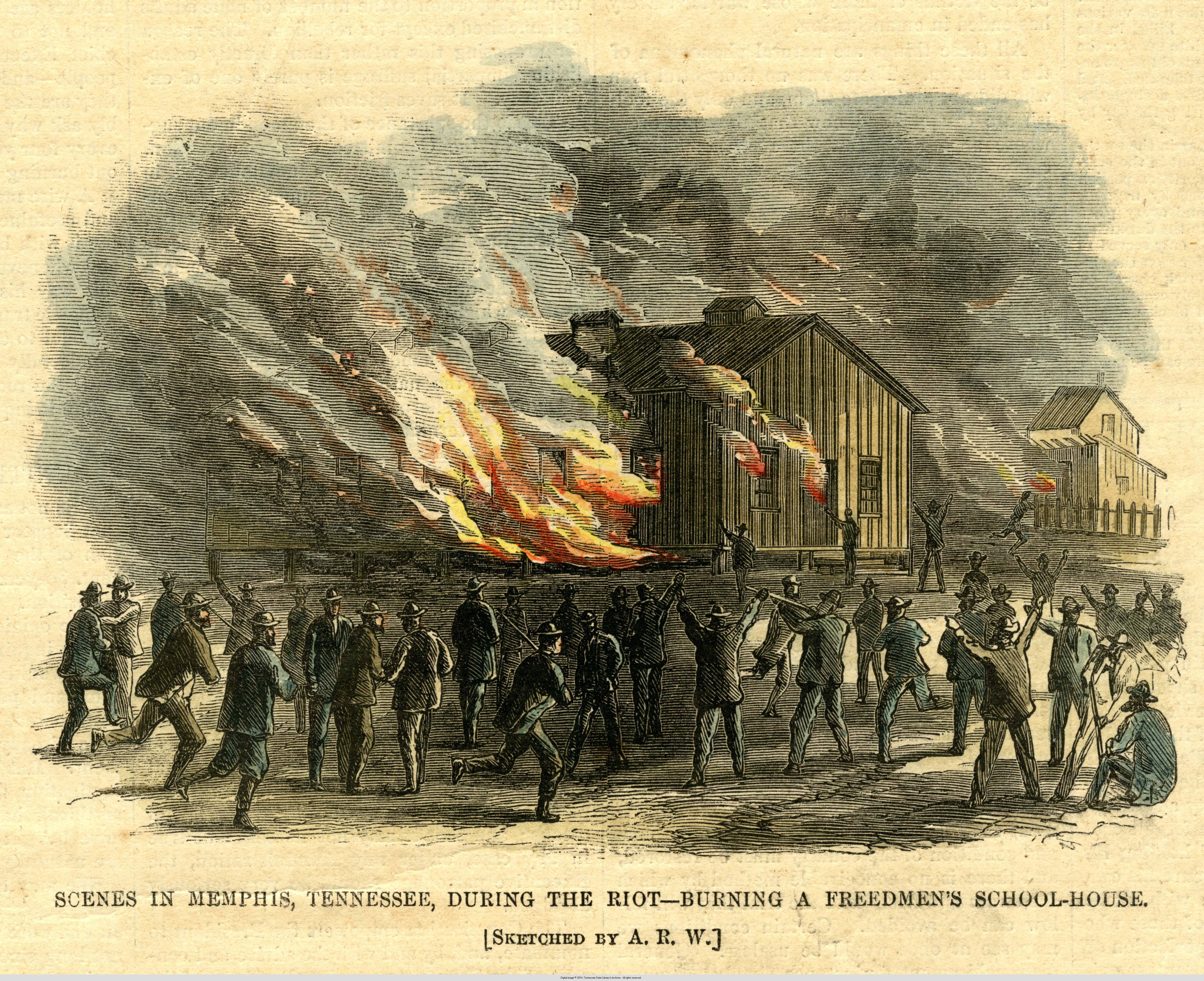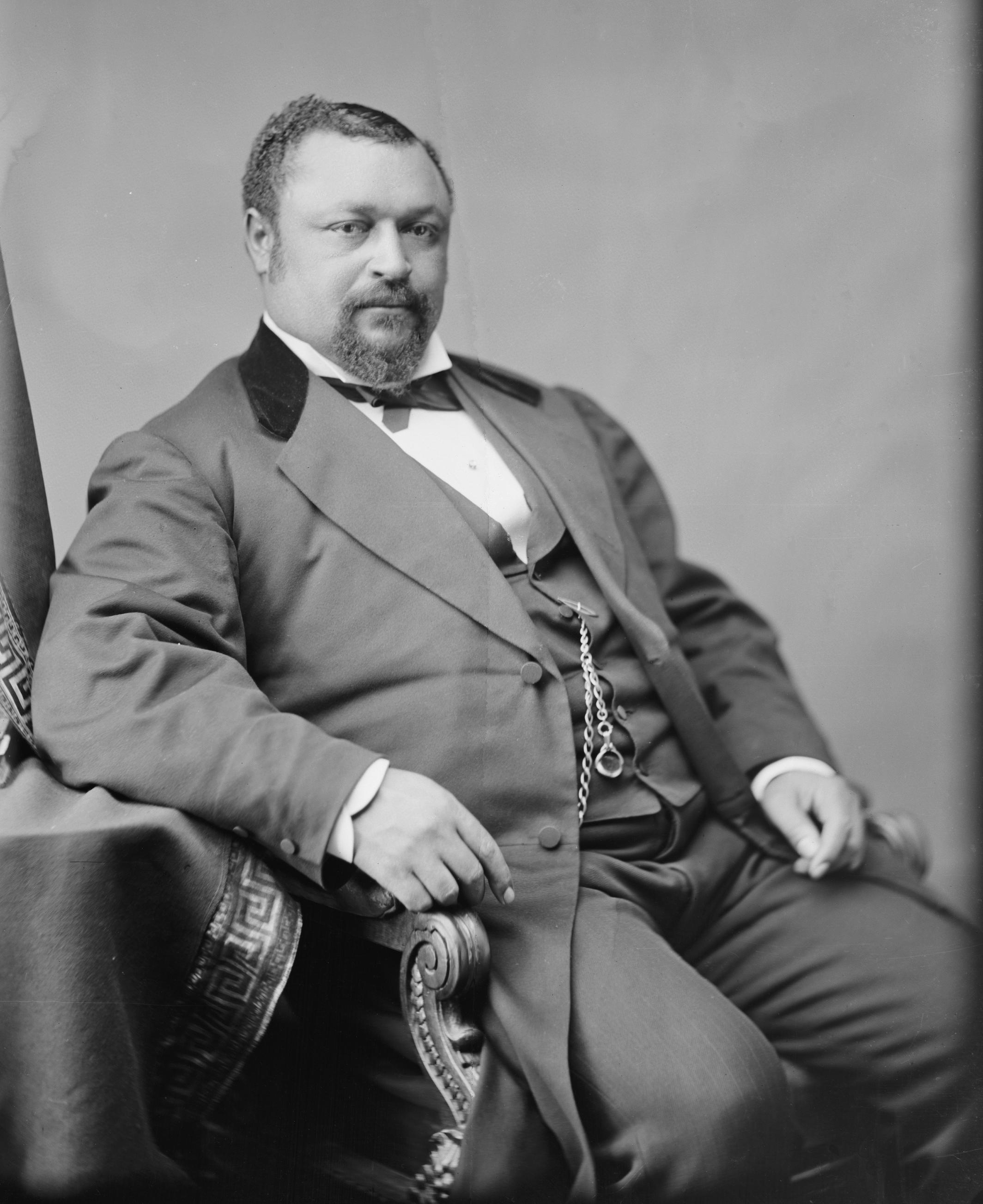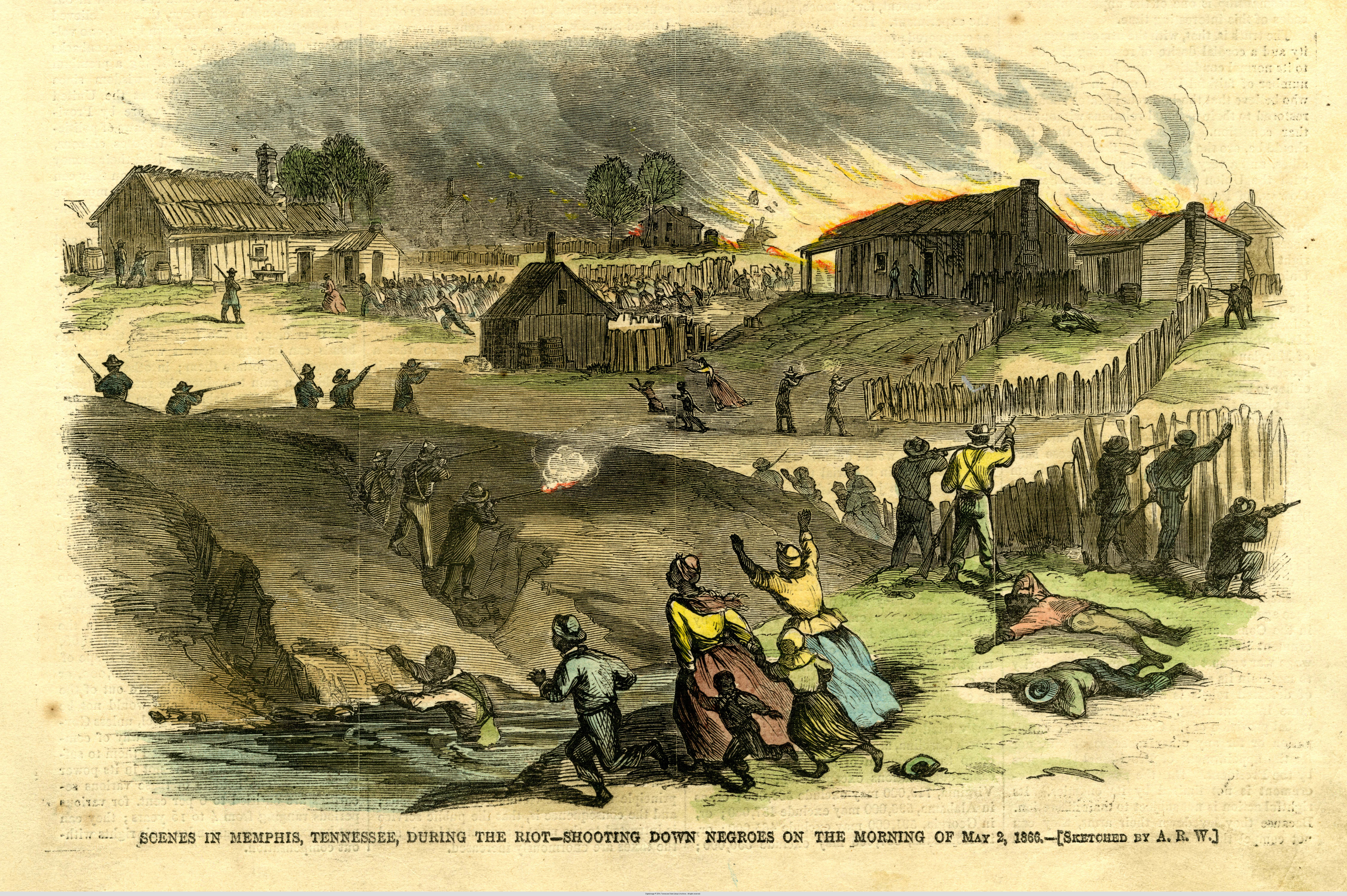
(Photo: Wikimedia Commons)
During the restive years following the Civil War, the Era of Reconstruction—often referred to as the nation’s Second Founding or the first Civil Rights Movement—America saw a virulent backlash from white supremacists in response to profound political, economic, and educational gains made by African Americans. During these years, more African Americans held office than at any other period in American history; in 2014 Tim Scott became the first African-American United States Senator elected in South Carolina since Reconstruction. Newly freed slaves established churches, schools, and businesses, and negotiated labor contracts with their former owners. Simultaneously, the period saw the re-emergence of the Ku Klux Klan, which used violence to impose a race-based social order where law no longer did; black codes were created to suppress African-American freedom, and segregation was institutionalized. White supremacists lynched an average of two to three African Americans weekly.
In more recent years, a somewhat unlikely agency—the National Park Service—has stepped up to consider how and whether to mark this period by way of national historic sites. In July the NPS released a report, the product of two years of commissioned academic research, detailing what events and locations should be marked for their historic significance relative to the Reconstruction era. It is a call for communities to take the next step and erect markers, with the agency’s support. The NPS’s ambition to have events of this era designated as National Historic Landmarks could have a great effect on the public’s understanding of racism’s pervasive roots in this country—a bold, and important, move for an agency that only recently began to take on the racial complexities of the Civil War.

Protests across the country calling to remove venerations of Confederate icons underscore the importance of learning proper history. “You cannot understand race in America today without understanding Reconstruction,” says Columbia University historian Eric Foner, a preeminent expert on the period. “It gets overshadowed by the Civil War, and it has been tremendously misunderstood over the years.”
In the century following Reconstruction, the narrative of the era was hotly contested. Early 20th-century white politicians depicted its chaos as evidence that African Americans should not be given equal rights or political power. “A certain view of Reconstruction was part of the edifice of racism in the United States. That view said that black people are fundamentally incapable of taking part in politics, that when they got the right to vote in reconstruction it led to corruption in misgovernment,” Foner says. This view was used to justify Jim Crow laws and became engrained in the American consciousness through films such as the 1915 drama Birth of a Nation, where the KKK is portrayed as heroes “saving” the South from incompetent black politicians. “That view [blaming African Americans for the period’s chaos] is still out there, though scholars have repudiated it for the last 50 years—it seems to take a long time for scholarly understanding to work its way out to the general public,” Foner says.
The NPS discussions began during the Clinton administration at the urging of Foner and other experts, and slowly percolated over the decades. Last year, as one of his last acts in office, President Barack Obama announced the creation of the NPS’s first national monument to the Reconstruction Era in Beaufort, South Carolina. The site includes the oak tree that William Henry Brisbane stood by during his first Southern reading of the Emancipation Proclamation, a church that held classes for former slaves, and a military camp where some of the first black U.S. soldiers were based.
The NPS operates nine Civil War military parks and 10 battlefields; its interpretation of the events that took place at those sites is instrumental to popular understanding of that war. It hopes that its 165-page report and memorials to follow will teach the public “the importance of this time period in our American experience. And how this Reconstruction transformed our nation,” says Michael Allen, the NPS’s community-partnership specialist for Reconstruction.
Instead of lauding the first African Americans elected to office as pioneers, history books most often skip them entirely. “A few, such as the senator from Mississippi, Blanche K. Bruce, are well known, but most have languished in obscurity. In addition, when modern historians have profiled them, they’re often used as scapegoats for the utter disaster that was Reconstruction,” writes Matthew Lynch, editor of Before Obama: A Reappraisal of Black Reconstruction Era Politicians. “Unfortunately, they were too far ahead of their time to be appreciated. Yet they still pioneered paths to power and influence that modern black politicians tread today, walking inexorably in the foot traces these towering figures left behind as a legacy to the future,” he writes.
The report lists about 30 historic sites where the public marker could be expanded to include its significance to Reconstruction, including the U.S. Custom House in downtown New Orleans where the embattled Republican government retreated for safety while white supremacist vigilantes attempted a coup in 1874. “The customhouse illustrates the centrality of violence to Reconstruction,” according to the report. “In the Battle of Liberty Place, the White League defeated the Metropolitan Police and inaugurated their own government, while Governor William Kellogg and loyalists huddled in the Customhouse until U.S. forces restored order.”

(Photo: Library of Congress)
Positive aspects of the era are also prominently highlighted, such as the home of Blanche K. Bruce, the first African American to serve a full term as a U.S. senator. “Many other black leaders who were politically active during Reconstruction also settled in Washington, D.C., where they could hope to work for the federal government or at Howard University as professionals,” the report says. Also suggested for memorialization in D.C. is the former home of journalist and abolitionist Mary Ann Shadd Cary, who taught in the city’s black public schools during Reconstruction and went on to become the second African-American woman to earn a law degree.
And it lists another 30 to be considered for National Historic Site designation, such as the Mitchelville Freedom Park in Hilton Head, South Carolina, which was the site of the first self-governed community of former slaves; the Thornhill House in New Orleans, which was a cotton factory occupied by the U.S. Army and later transformed into the Freedmen’s Bureau headquarters, where officials oversaw the creation of schools for former slaves; and Bennett College Historic District in Greensboro, North Carolina, a historically black women’s liberal arts college founded by Reconstruction politician and novelist Albion W. Tourgée.

If communities take up the NPS’s call to erect or expand memorials to this era, a 2015 racially charged battle of semantics in Memphis, Tennessee, might offer a hint of what’s to come. There, the local chapter of the National Association for the Advancement of Colored People applied to have an historic marker placed downtown describing the 1866 Memphis Massacre, an event some historians say spurred the federal government to ratify the Fourteenth Amendment, which granted citizenship to “all persons born or naturalized in the United States,” including former slaves. The consensus version of the story among scholars is as follows: About a year after the Confederacy surrendered, a rumor spread through Memphis that recently discharged black soldiers were planning an uprising. White Memphians mobilized to take vengeance for the purported plot. A mob, led by police officers and local government officials, attacked the African-American community for three days. According to an Army investigation at the time, the “Negroes were hunted down by police, firemen and other white citizens, shot, assaulted, robbed, and in many instances their houses searched under the pretense of hunting for concealed arms, plundered, and then set on fire.” And, “during [this] no resistance … was offered by the Negroes.”
All told, the mob wrecked 90 other buildings, including the four black churches and 12 black schools. They killed 46 black citizens and raped and injured dozens of others. The violence made national headlines and led to three federal investigations, but no arrests were made. This was less than a month after the federal Congress passed the Civil Rights Act of 1866, which outlawed race-based discrimination and guaranteed all citizens equal protection under the law.
Like many Reconstruction-era events, the Memphis Massacre escaped most history books. Phyllis Aluko, a native Memphian and local public defender, was disturbed that she hadn’t learned about such a major incident until she was an adult. So, two years ago, she crafted a proposal that a historical marker to the event be posted downtown on its 150th anniversary, which fell on May 1st, 2016. Aluko found ready sponsors: the NAACP—an organization of which she is a member—and, later, the NPS.

(Photo: Wikimedia Commons)
Aluko submitted the proposal to the Tennessee Historical Commission, a governor-appointed unpaid panel, which, at that time, had 24 members, 19 of whom were white. Only one member initially opposed Aluko’s proposed text. The dissenter, a local bankruptcy lawyer, proposed an alternate text labeling the event “The Memphis Race Riot of 1866,” and referred to the attackers as rioters. “That is not our modern concept of a riot, targeting a group of people because you want to assert dominance of that group,” Aluko says. “It fits the definition of a massacre. If the race of the victims and the perpetuators were switched I don’t think anyone would disagree,” she says.
Over the course of two commission meetings, one in October of 2015 and one in February of 2016, at both of which Aluko made her case, the lone dissenter moved other commission members to his side. The text was tweaked and tweaked, always retaining the race riot language. “Black people didn’t have a voice then, it seemed patently unfair 150 years later for us not to have a voice naming what occurred,” she says.
At the February meeting, the great-great-grandsons of Nathan Bedford Forrest—a Confederate general, slave tycoon, and founding member of the KKK—were invited without explanation. At that same meeting, a local historian, Lee Millar, was invited to give testimony on why he thought the riot language was correct. Millar is the former chairman of the Shelby County Historical Commission, and the regional spokesman for the Sons of Confederate Veterans. The incident was a riot, he argued, because that is how local papers recorded it at the time. “One of the things that the Historical Commission was supposed to do was to educate and promote history and reflect it as it was understood at the time, and not rebrand it as current opinion might,” he says.
“It struck me that, in 1866, the newspapers weren’t African American; most were run by Confederate sympathizers,” Aluko says. “It was a misrepresentation of what occurred, and, 150 years later, I didn’t want to make the same mistake again.”
The state commission decided to go forward with its version whether the NAACP approved of it or not. At this point the NPS became formally involved, co-sponsoring the NAACP’s version. Ultimately, the two agencies circumvented the state commission altogether and went straight to the city for approval. On May 1st, 2016, a plaque to the “Memphis Massacre of 1866” was erected in downtown Memphis. “On May 1, 2 and 3, 1866, mobs of white men led by law enforcement attacked black people,” the placard reads, “By the end of the attack, the mobs had killed an estimated 46 black people; raped several black women; and committed numerous robberies, assaults and arsons.” At the bottom it notes the plaque’s two sponsors, the NAACP and the NPS.
Taking on Reconstruction “is part of an evolution” for the NPS, Allen says. The willingness to take on America’s legacy of white supremacy is on display in its Civil War battlefield memorials too, which, until recently, were “guns and drums” sites but now include elements such as narratives of black soldiers. “We can say publicly that one of the central causes of the Civil War was slavery. We didn’t say that when I got here in 1980,” he says.
Deirdre Cooper Owens, an assistant professor of history at Queens College–City University of New York, who peer-reviewed the NPS’s report, says that she hopes communities will erect markers that include both African-American achievements during Reconstruction and the violent backlash that arose in opposition to those achievements. Owens adds that marking sites of violence isn’t anything new. “We have markers to massacres already, but many of them are tied to the Civil War or the Revolutionary era,” she says. But “with Reconstruction, we’re now being very precise about who the victims were. Nine out of 10 times the victims tended to be formerly enslaved black people. So, there is racial guilt when having to reckon with what happened,” Owens says.
Many of the questions American grappled with during Reconstruction are still relevant today, Foner says. “Who should be considered a citizen? That’s a Reconstruction issue. Who should have the right to vote? That’s a Reconstruction issue. Terrorism, the Ku Klux Klan, that comes out of Reconstruction. It’s important historically, but it’s really the origins of a lot present-day controversies and inequities,” he says—but, he adds, whether the Confederacy stood for slavery or not is a purely modern question. “Everybody knew the Confederacy was all about slavery. We didn’t have Trump around to say it wasn’t.”





